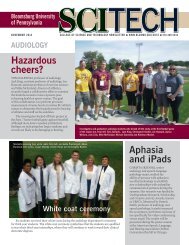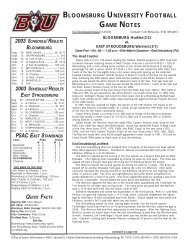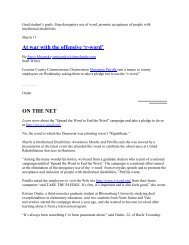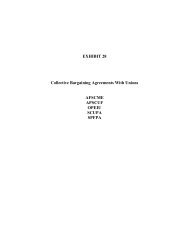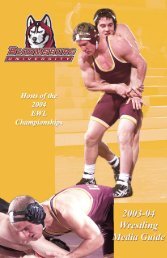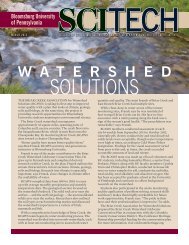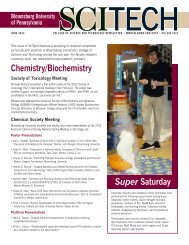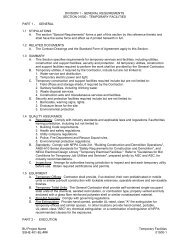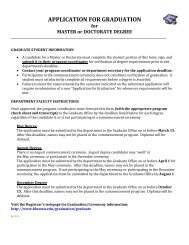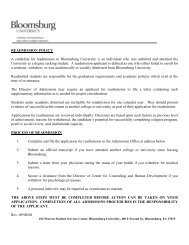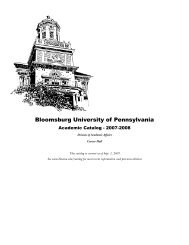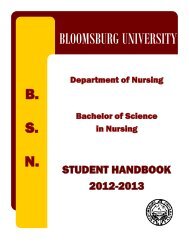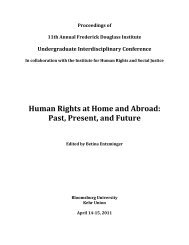RUNNING, PHILLY STYLE - Bloomsburg University
RUNNING, PHILLY STYLE - Bloomsburg University
RUNNING, PHILLY STYLE - Bloomsburg University
You also want an ePaper? Increase the reach of your titles
YUMPU automatically turns print PDFs into web optimized ePapers that Google loves.
PHOTO: GORDON WENZEL/IMPRESSIONS<br />
one group to another. And what we’re looking for is precision.<br />
“I know what absolute precision sounds like and looks<br />
like,” he says. “It doesn’t<br />
Gifford Howarth<br />
demonstrates his<br />
marimba technique at<br />
www.bloomu.edu/<br />
magazine.<br />
happen very often, but I’ve<br />
been fortunate enough to<br />
have worked with groups<br />
and adjudicated groups<br />
that have been at that<br />
level. We look for the concept<br />
of uniformity, with<br />
multiple people playing<br />
the same thing at the same time. We ask: Are they expressing<br />
the music the same way? Are performers bringing across<br />
the mood and style of the music?”<br />
Judging some of the most talented marching bands in the<br />
world is just one opportunity Howarth<br />
has pursued in a career of performing,<br />
teaching and traveling. With advanced<br />
degrees from Kent State and Michigan<br />
State universities, he credits an undergraduate<br />
professor at Ithaca College,<br />
percussionist Gordon Stout, with nurturing<br />
his passion for music and helping<br />
him develop his skills as a mallet percussionist<br />
on the marimba.<br />
‘Wow moments’<br />
Howarth describes the marimba as “a<br />
xylophone on steroids.” A solo percussion<br />
instrument, the modern marimba<br />
dates back to the early 1900s, but has<br />
grown exponentially in popularity<br />
over the past 20 years. Howarth con-<br />
ducts workshops focused on how to introduce and teach relatively<br />
new marimba techniques to percussionists.<br />
“The popularity of these workshops led to the production of<br />
a method book,” Howarth says. Published in 2002, his book,<br />
Simply Four, focuses on how to teach the Stevens grip — a fourmallet<br />
technique, which requires percussionists to hold two<br />
mallets in each hand.<br />
While the technique itself has been around since the 1970s,<br />
Howarth’s<br />
method provides<br />
anewwayto<br />
teach the grip to<br />
percussionists at<br />
earlier stages of<br />
development.<br />
“I’m riding the<br />
Assistant music professor Gifford Howarth, left,<br />
instructs Erik Scattareggia, a senior music major<br />
from Media.<br />
“I enjoy seeing the light bulbs go<br />
on with students, both the<br />
students I have worked with<br />
for three or four years, and the<br />
students I have for just one day.”<br />
wave, in a sense,” he says. “High school students are now doing<br />
what college kids were just starting to learn 20 years ago.”<br />
A passion for percussion came naturally to Howarth, who<br />
began taking lessons in middle school. “You<br />
start on one instrument, a snare drum, to<br />
develop basic rhythm. But there are so many<br />
instruments: cymbals, mallets, timpani. It’s<br />
such a vast genre.”<br />
By high school, Howarth was thinking<br />
about a career in the music business.<br />
“There was a ‘wow moment’ the first time I<br />
was at a drum corps show in my senior<br />
year in high school, seeing professionallevel<br />
marching performance that I didn’t<br />
know existed,” he says.<br />
And, in graduate school, he learned firsthand<br />
how a great performance can have far-reaching<br />
echoes when he experienced a percussion concerto<br />
by Christopher Lamb,<br />
principal percussionist with the<br />
New York Philharmonic and<br />
faculty member at the<br />
Manhattan School of Music. “It<br />
just blew me away,” he says.<br />
“That was a second ‘wow<br />
moment’ and it inspired me to<br />
become a more serious student.”<br />
Today, Howarth hopes to<br />
inspire “wow moments” for the<br />
next generation of students at<br />
seminars in high schools and<br />
colleges worldwide. “The<br />
music world is a pretty small<br />
community,” he says, noting<br />
that early opportunities also<br />
opened doors for him to teach and judge Drum<br />
Corps International competitions and instruct<br />
at Yong Siew Toh Conservatory of Music at the<br />
<strong>University</strong> of Singapore. In January, Howarth<br />
spent a week in Thailand as an adjudicator for<br />
the Royals Cup Concert marching band contest<br />
and, while there, taught the four-mallet<br />
marimba technique at Kasetsart <strong>University</strong>,<br />
near Bangkok.<br />
Howarth’s relationships with percussion<br />
manufacturers have enriched the music experience<br />
of the <strong>Bloomsburg</strong> community, as well.<br />
A national performing artist for Yamaha, he<br />
helped bring the Yamaha Sounds of Summer<br />
percussion camp to BU for the past three<br />
years. The camp, hosted by BU’s music department,<br />
provides complete marching percussion<br />
training for students in middle school and<br />
high school.<br />
CONTINUES ON NEXT PAGE<br />
SPRING 2010<br />
19



